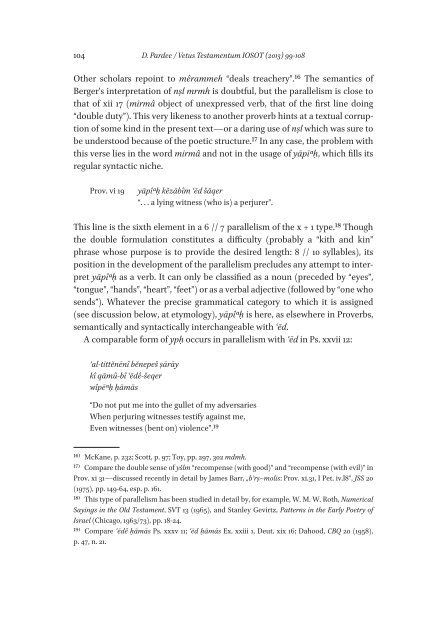Special Issue IOSOT 2013 - Books and Journals
Special Issue IOSOT 2013 - Books and Journals
Special Issue IOSOT 2013 - Books and Journals
You also want an ePaper? Increase the reach of your titles
YUMPU automatically turns print PDFs into web optimized ePapers that Google loves.
104 D. Pardee / Vetus Testamentum <strong>IOSOT</strong> (<strong>2013</strong>) 99-108<br />
Other scholars repoint to mêrammeh “deals treachery”.16 The semantics of<br />
Berger’s interpretation of nṣl mrmh is doubtful, but the parallelism is close to<br />
that of xii 17 (mirmâ object of unexpressed verb, that of the first line doing<br />
“double duty”). This very likeness to another proverb hints at a textual corruption<br />
of some kind in the present text—or a daring use of nṣl which was sure to<br />
be understood because of the poetic structure.17 In any case, the problem with<br />
this verse lies in the word mirmâ <strong>and</strong> not in the usage of yāpīaḥ, which fills its<br />
regular syntactic niche.<br />
Prov. vi 19<br />
yāpîaḥ kĕzābîm ʿēd šāqer<br />
“. . . a lying witness (who is) a perjurer”.<br />
This line is the sixth element in a 6 // 7 parallelism of the x + 1 type.18 Though<br />
the double formulation constitutes a difficulty (probably a “kith <strong>and</strong> kin”<br />
phrase whose purpose is to provide the desired length: 8 // 10 syllables), its<br />
position in the development of the parallelism precludes any attempt to interpret<br />
yāpîaḥ as a verb. It can only be classified as a noun (preceded by “eyes”,<br />
“tongue”, “h<strong>and</strong>s”, “heart”, “feet”) or as a verbal adjective (followed by “one who<br />
sends”). Whatever the precise grammatical category to which it is assigned<br />
(see discussion below, at etymology), yāpîaḥ is here, as elsewhere in Proverbs,<br />
semantically <strong>and</strong> syntactically interchangeable with ʿēd.<br />
A comparable form of ypḥ occurs in parallelism with ʿēd in Ps. xxvii 12:<br />
ʾal-tittĕnēnî bĕnepeš ṣārāy<br />
kî qāmû-bî ʿēdê-šeqer<br />
wîpēaḥ ḥāmās<br />
“Do not put me into the gullet of my adversaries<br />
When perjuring witnesses testify against me,<br />
Even witnesses (bent on) violence”.19<br />
16) McKane, p. 232; Scott, p. 97; Toy, pp. 297, 302 mdmh.<br />
17) Compare the double sense of yšlm “recompense (with good)” <strong>and</strong> “recompense (with evil)” in<br />
Prov. xi 31—discussed recently in detail by James Barr, „bʾrṣ~molis: Prov. xi.31, I Pet. iv.l8”, JSS 20<br />
(1975), pp. 149-64, esp. p. 161.<br />
18) This type of parallelism has been studied in detail by, for example, W. M. W. Roth, Numerical<br />
Sayings in the Old Testament, SVT 13 (1965), <strong>and</strong> Stanley Gevirtz, Patterns in the Early Poetry of<br />
Israel (Chicago, 1963/73), pp. 18-24.<br />
19) Compare ʿēdê ḥāmās Ps. xxxv 11; ʿēd ḥāmās Ex. xxiii 1, Deut. xix 16; Dahood, CBQ 20 (1958),<br />
p. 47, n. 21.








![Am HaSefer [Volk des Buches] - Books and Journals](https://img.yumpu.com/20648352/1/174x260/am-hasefer-volk-des-buches-books-and-journals.jpg?quality=85)







